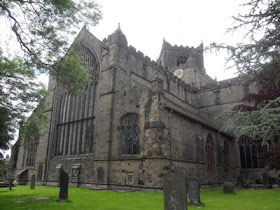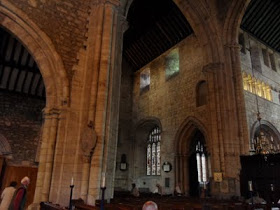This week is important in Edward II World :) for various anniversaries...
18 June: Edward and Isabella's elder daughter Eleanor was born at the palace of Woodstock in 1318, and named after Edward's mother Eleanor of Castile. Edward - then thirty-four - had been in Canterbury, apparently on pilgrimage, but arrived in Woodstock on the day of his daughter's birth. His Wardrobe account records a payment of 500 marks to "Lady Isabella, queen of England, of the king's gift, for the feast of her purification after the birth of the Lady Alienora her daughter." Eleanor married, shortly before her fourteenth birthday in 1332, Count (later Duke) Reynald II of Gelderland, and had two sons, named after her husband and her father; the marriage to King Alfonso XI of Castile planned for her by Edward didn't come off. Edward's chamber journal of 1326 reveals that he appointed Jonete Germye (or Jermy) sister of his sister-in-law Alice Hales, countess of Norfolk, as the governess (mestresse) of his two daughters, and paid a messenger five shillings to take his letters to the little girls, then aged eight and five, in Marlborough on 25 July that year.
19 June: I could hardly let the anniversary of Piers Gaveston's death in 1312 pass without comment! RIP Piers Gaveston, earl of Cornwall and beloved of a king. (See Anerje's post remembering him too.)
19 June: the day in 1313 when Edward watched 54 naked dancers perform for him in Pontoise.
19 June: the day in 1320 when Edward set sail for France to pay homage to his brother-in-law Philippe V for Gascony and Ponthieu.
20 June: the day in 1316 when Edward sent his kinsman the earl of Pembroke to deal with the rebellion in Bristol.
23 June: the anniversary of the first day of the battle of Bannockburn in 1314. Don't think I need to say much about it, really...:)
23 June: the day in 1324 when Aymer de Valence, earl of Pembroke, died suddenly on his way to Paris to negotiate with Charles IV on Edward's behalf.
24 June: the feast of the Nativity of St John the Baptist, one of Edward's favourite saints. The king marked the day in 1317 wearing (presumably) "a crown of wax of various colours and of various devices" for which he had paid two pounds, and in 1326 spent five shillings playing dice with Sir Giles Beauchamp and unnamed other members of his household in the Tower of London.
25 June: the day in 1308 on which Piers Gaveston was ordered to depart from England (he sailed for Ireland to take up his role as king's lieutenant), in his second exile.
27 June: the day he returned a year later. :-)
28 June: on this day in 1323, Edward II ordered the bishop of London to prevent people praying and making offerings at a tablet in St Paul's "whereon are depicted statues, sculpture or images of diverse persons," having learned that many people went to "worship it as a holy thing." The problem was that one of the persons thereon depicted was his cousin Thomas of Lancaster, whom he had had executed the previous year.
29 June: on this day in 1317, five years and ten days after Piers' death, Edward ordered abbot and convent of Thame to take on six additional monks "to celebrate divine service daily in the abbey for the souls of the king’s ancestors, and of Piers de Gaveston, earl of Cornwall." And in 1320, he paid liege homage to Philippe V at Amiens.
Welcome to the site which examines the events, issues and personalities of Edward II's reign, 1307-1327.
Pages
▼
23 June, 2011
15 June, 2011
Cartmel Priory
A building I visited a few days ago: Cartmel Priory in South Cumbria, founded in about 1190 by the great William Marshal (1146/47-14 May 1219), earl of Pembroke, lord of Cartmel and regent of England for Edward II's grandfather Henry III. Via his five daughters (his five sons all died childless), William was the ancestor of most of the English nobility of Edward II's era; his namesake William Marshal, a descendant of one of his brothers, was killed at Bannockburn in 1314. Cartmel was spelled Kertmel or Kertmele in the early fourteenth century, and there are various references in Edward II's reign to the prior. The priory was dissolved in 1536, and only the church survives (and was used as a stable by some of Oliver Cromwell's troops in 1643).
 |
| Misericords in the choir, which date to 1440 |
 |
| The tomb of Sir John Harington (knighted with Edward of Caernarfon in 1306, died 1347) and his wife Joan. |
02 June, 2011
Blog Break And Links
This is my last post for a little while, as I'm off on holiday! The second part of my post about Henry of Lancaster will appear after my return, I hope. :)
In the meantime, here are some blogs to check out, all written by good friends of mine:
- Anerje's blog about Piers Gaveston, which takes in other periods of history as well. Her latest post is a fascinating one about Piers' health, or rather the lack of it.
- Ashmodiel/Rowan's blogs Seelenlicht (in German) and Wings of Inspiration (with Tricia Danby), with examples of their great artwork and quite a few mentions of Edward II and Piers Gaveston. :-)
- Paula's blog Sons of the Wolf, with extracts from her fantastic novel of the same name and factual posts about eleventh-century England.
- Christy's blog Rooting for Ancestors, with lots of interesting posts about genealogy and history.
Michael Jecks' novel King's Gold, the latest instalment in his popular Knights Templar Mysteries series, was released in the UK a few days ago. Many thanks to Mike for sending me a copy and mentioning me in the acknowledgements.
See you in a couple of weeks!
In the meantime, here are some blogs to check out, all written by good friends of mine:
- Anerje's blog about Piers Gaveston, which takes in other periods of history as well. Her latest post is a fascinating one about Piers' health, or rather the lack of it.
- Ashmodiel/Rowan's blogs Seelenlicht (in German) and Wings of Inspiration (with Tricia Danby), with examples of their great artwork and quite a few mentions of Edward II and Piers Gaveston. :-)
- Paula's blog Sons of the Wolf, with extracts from her fantastic novel of the same name and factual posts about eleventh-century England.
- Christy's blog Rooting for Ancestors, with lots of interesting posts about genealogy and history.
Michael Jecks' novel King's Gold, the latest instalment in his popular Knights Templar Mysteries series, was released in the UK a few days ago. Many thanks to Mike for sending me a copy and mentioning me in the acknowledgements.
See you in a couple of weeks!















